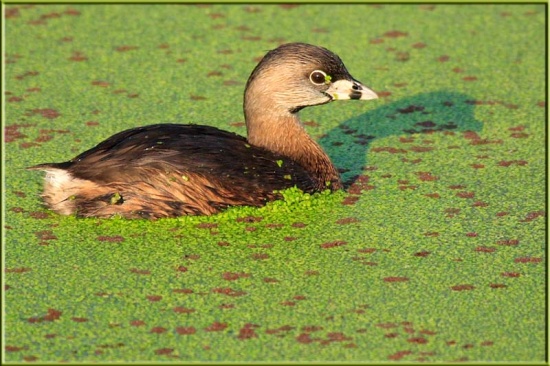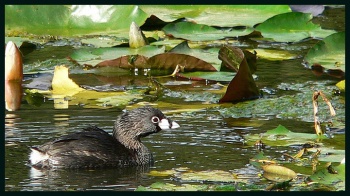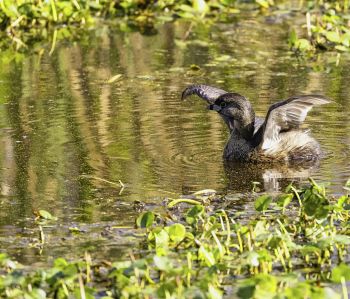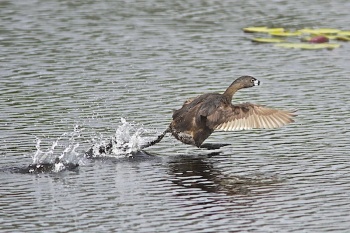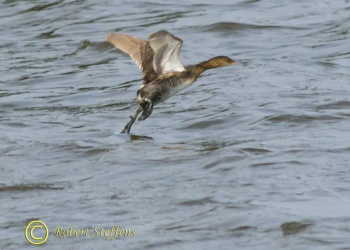- Podilymbus podiceps
Identification

Photo © by David Roach
Green Cay Wetlands, Boynton Beach, Florida, USA, 8 November 2018
L. 30-38cm (11¾-15 cm), Ws. 59cm
Lacks a distinct wing-bar in flight
Adult breeding
- Dark gray-brown above
- Paler gray-brown, tinged rufous, on breast and flanks
- Belly and fluffy undertail-coverts white
- Head and hindneck dark gray-brown or blackish
- Sides of head paler and tinged rufous
- Black chin and throat
- Short, thick bill
- White with black central band
- White with black central band
Adult non-breeding: similar to breeding adult but duller and browner, lacks black chin and bill-band
Juvenile: like non-breeding adult but has striped head.
Variations
The three subspecies vary slightly in colour of upperparts, overall size, bill size and extent of bill-band and chin patch.
Distribution
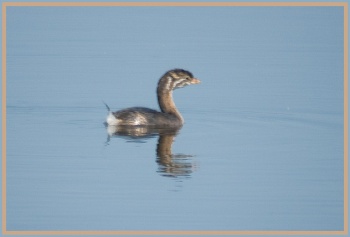
Photo © by gophish
Montezuma National Wildlife Refuge, central New York state, 16 August 2008
A widespread American grebe breeding almost throughout the USA and in south-central and south-eastern Canada. Further south breeds in Mexico and Central America, in the West Indies and in South America from Colombia and Venezuela south to southern Argentina.
Transatlantic vagrants are regularly recorded, most often in Britain and the Azores but also recorded in Iceland, France, Spain, the Canary Islands and east to Germany and Poland. Nest-building has taken place in France and hybridisation with Little Grebe (Tachybaptus ruficollis) has occurred in Britain and Norway. Also recorded as a vagrant on the Galapagos Islands.
Northernmost birds are migratory and much of the eastern and central North American range is vacated in winter.
Taxonomy
Subspecies
There are 3 subspecies[1]:
- P. p. podiceps:
- South and Central Canada to Panama, winters South USA, Central America and West Indies
- P. p. antillarum:
- Breeds in the West Indies: Greater and Lesser Antilles
- P. p. antarcticus:
Habitat
Breeds on shallow, well-vegetated freshwaters, in winter on larger and more open waters, sometimes estuaries but very rarely on the sea.
Behaviour
Shy and secretive particularly during the breeding season.
Flight
Compact shape and thick bill should identify this species at all seasons.
Diet
Its diet includes small fish, frogs and tadpoles and aquatic invertebrates.
Breeding
Breeding season varies with latitude, usually begins mid-May in northern parts of range, earlier further south and all months in tropical areas. Breeds beside small-large freshwaters, nest is a heap of floating vegetation on edge of reedbeds or other marginal vegetation, sometimes on the bottom in shallow water. Eggs: 4-7 (rarely 2-10), whitish, tinged bluish or buff initially soon becoming stained (44 x 30mm). Incubated by both sexes but mainly female for 23-24 days. Young tended by both sexes. Single or double-brooded.
Vocalisation
Whinnying call during the breeding season ending with slower, gulping cow-cow-cow notes. Generally silent outside breeding season.
Movements
Basically sedentary, however, birds from the northernmost populations head south after breeding to winter in Baja California.
References
- Clements, J. F., T. S. Schulenberg, M. J. Iliff, S. M. Billerman, T. A. Fredericks, B. L. Sullivan, and C. L. Wood. 2019. The eBird/Clements Checklist of Birds of the World: v2019. Downloaded from http://www.birds.cornell.edu/clementschecklist/download/
- Llimona, F., del Hoyo, J., Christie, D.A., Jutglar, F. & Kirwan, G.M. (2020). Pied-billed Grebe (Podilymbus podiceps). In: del Hoyo, J., Elliott, A., Sargatal, J., Christie, D.A. & de Juana, E. (eds.). Handbook of the Birds of the World Alive. Lynx Edicions, Barcelona. (retrieved from https://www.hbw.com/node/52482 on 16 February 2020).
- Muller, M. J. and R. W. Storer (1999). Pied-billed Grebe (Podilymbus podiceps), version 2.0. In The Birds of North America (A. F. Poole and F. B. Gill, Editors). Cornell Lab of Ornithology, Ithaca, NY, USA. https://doi.org/10.2173/bna.410
Recommended Citation
- BirdForum Opus contributors. (2025) Pied-billed Grebe. In: BirdForum, the forum for wild birds and birding. Retrieved 30 April 2025 from https://www.birdforum.net/opus/Pied-billed_Grebe
External Links
GSearch checked for 2020 platform.1




